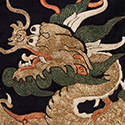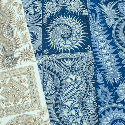|
|
| Show All 12 Results (Text Only) |
|
| Imperial Silks (of the Manchu Court) |

|
| Minneapolis Institute of Arts
|
"When the nomadic Manchu warriors overthrew the Ming dynasty in 1644 and founded Ch'ing [Qing], they took over the world's largest population, greatest bureaucracy, and one of the most luxurious courts in existence. They remained, however, a clear minority... To ease an orderly political transition while guarding against total cultural assimilation, the Manchus adjusted to a Chinese style bureaucracy and adopted the Buddhist religion while simultaneously enforcing certain ethnic and cultural differences. One of the clearest distinctions made was that of court attire." An overview, plus 14 related examples of court attire from the Manchu period, all with descriptions.
Go to Museum Resource: http://archive.artsmia.org/art-of-asia/explore/explore-collection-imperial-silk... | |
|
|
| Kimono |

|
| Victoria and Albert Museum
|
"Japan has a very rich textile history, a major focus of interest and artistic expression being the kimono. Meaning 'the thing worn,' the term kimono was first adopted in the mid-19th century." A special feature about the kimono, with in-depth discussions of the kimono's history, production (weaving, dyeing, embroidery), and decoration (symbols and motifs), plus 51 kimonos from the V&A's collection.
Go to Museum Resource: http://www.vam.ac.uk/page/k/kimono/ | |
|
|
| The Artful Fabric of Collecting |
|
| Jordan Schnitzner Museum of Art, University of Oregon
|
Chinese textiles from the collection of Gertrude Bass Warner (1863-1951), who… was particularly drawn to silk textiles and the people who produced them, primarily the women in private households and commercial workshops. Techniques and patterns of weaving silk for Chinese robes are demonstrated on the site. It was only in the 17th century when the production of court orders began to overwhelm the imperial workshops that commercial workshops took over some of the production. In these commercial workshops, most of them located in the Jiangnan area, the center of China’s silk production, male weavers relegated women to the groundworks of silk production: the rearing of the silkworms and reeling the silk of the cocoons. Embroidery remained the domain of women. They were the master embroiderers who developed the art to its height in the Qing Dynasty (1644-1911). Their legacy can be admired in the textiles from the Warner collection.
Go to Museum Resource: https://glam.uoregon.edu/s/fabric-of-collecting/page/welcome | |
|
|
|
| China’s Long Nineteenth Century – Foreign Influence and the End of Dynastic China |
|
| National Museum of Asian Art, Smithsonian Institution
|
Students will be able to explain the various reasons why the Qing dynasty was weakened during the nineteenth century, especially with regard to the outside influence of foreign powers.
Go to Museum Resource: https://asia.si.edu/learn/for-educators/teaching-china-with-the-smithsonian/les... | |
|
|
| Designing with Numbers |
|
| National Museum of Asian Art, Smithsonian Institution
|
Students will look closely at a Qing dynasty court robe known as a chaofu. They will learn about the beliefs in Chinese numerology and its relationship to language. After counting the symbols, they will learn why specific numbers of special images appear on the robe. Several related math problems are included.
Go to Museum Resource: https://asia.si.edu/learn/for-educators/teaching-china-with-the-smithsonian/les... | |
|
|
|
| Miyake, Kawakubo, and Yamamoto: Japanese Fashion in the Twentieth Century |
|
| The Metropolitan Museum of Art
|
An introduction to Japanese fashion since the 1960s, with a focus on the designers Issey Miyake, Rei Kawakubo, and Yohji Yamamoto. With 10 examples of the artists' works from the museum's collection.
Go to Museum Resource: http://www.metmuseum.org/toah/hd/jafa/hd_jafa.htm | |
|
|
|
| Show All 12 Results (Text Only) |








